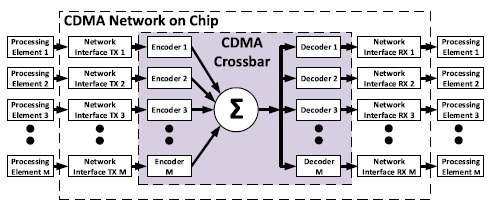- ALL COMPUTER, ELECTRONICS AND MECHANICAL COURSES AVAILABLE…. PROJECT GUIDANCE SINCE 2004. FOR FURTHER DETAILS CALL 9443117328


Projects > ELECTRONICS > 2017 > IEEE > VLSI
On-chip interconnects are the performance bottleneck in modern system-on-chips. Code-division multiple access (CDMA) has been proposed to implement on-chip crossbars due to its fixed latency, reduced arbitration overhead, and higher bandwidth. In CDMA, medium sharing is enabled in the code space by assigning a limited number of N-chip length orthogonal spreading codes to the processing elements sharing the interconnect. In this paper, we advance overloaded CDMA interconnect (OCI) to enhance the capacity of CDMA network-on-chip (NoC) crossbars by increasing the number of usable spreading codes. Serial and parallel OCI architecture variants are presented to adhere to different area, delay, and power requirements. Compared with the conventional CDMA crossbar, on a Xilinx Artix-7 AC701 FPGA kit, the serial OCI crossbar achieves 100% higher bandwidth, 31% less resource utilization, and 45% power saving, while the parallel OCI crossbar achieves N times higher bandwidth compared with the serial OCI crossbar at the expense of increased area and power consumption.
Adaptive Routing Algorithm.
In this paper, we introduced the concept of overloaded CDMA crossbars as the physical layer enabler of NoC routers. In overloaded CDMA, the communication channel is overloaded with non-orthogonal codes to increase the channel capacity. The contributions of this paper are as follows. Introduce two novel approaches that can be deployed in CDMA NoC crossbars to increase the router capacity and, consequently, bandwidth by 100% at marginal cost. Present the OCI mathematical foundations, spreading code generation procedures, and OCI-based router architectures. Develop and evaluate the OCI-based routers built on a Xilinx Artix-7 AC701 evaluation kit and using a 65-nm ASIC technology for several synthetic traffic patterns and compare their latency, bandwidth, and power consumption with the basic CDMA and SDMA switching topologies.
CDMA NoC router architecture

Classical CDMA crossbar